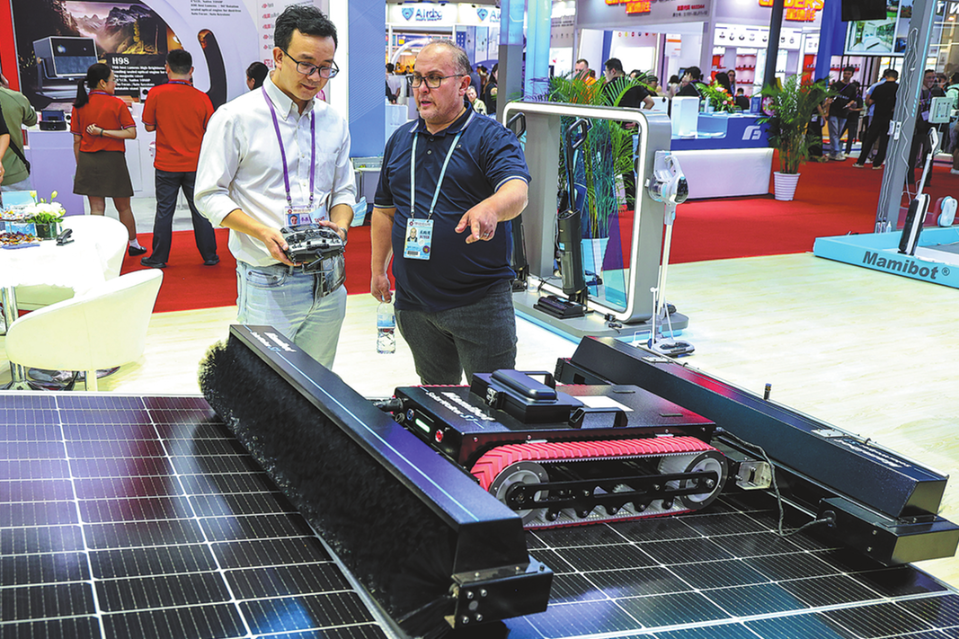Power reduction
Green finance solutions can help address the energy challenges in the age of explosive AI growth


The explosive growth of artificial intelligence is reshaping the technological landscape, industrial structures and everyday life at an unprecedented pace. At the World Artificial Intelligence Conference held in Shanghai this July, in addition to discussions on algorithm breakthroughs and industrial applications, another topic that drew intense attention was the rising energy consumption driven by AI development. As large-scale models and intelligent computing centers expand rapidly, energy consumption behind these technologies is also growing at an astonishing rate. Many experts and industry professionals are realizing that without effective guidance and regulation, the rapid expansion of AI could pose a significant challenge to long-term green goals such as carbon neutrality.
During the conference, many forums frequently discussed the concept of the "AI energy paradox", which claims that, on the one hand, AI technologies can significantly improve energy efficiency through algorithm optimization, and on the other hand, their high-density computing demands result in massive electricity consumption. Particularly, training large models and building high-performance computing clusters lead to significant energy use and carbon emissions. While some data centers are situated in the western region of China rich in clean energy resources, challenges such as unstable power grid connections and inefficient cooling systems have hindered their overall environmental performance.
To address these challenges systematically, French industrial conglomerate Schneider Electric released a report titled Computing Collaboration — Energy Challenges and Responses in Data Centers at the conference, proposing a "three-tier framework" aimed at promoting coordinated development between computing capacity and electricity supply. The key elements consist of: first, strengthening the power infrastructure by increasing renewable energy integration and enhancing the resilience of distribution networks to optimize clean energy use; second, at the computing level, boosting resource efficiency through elastic load management and energy-saving algorithms to lower energy consumption per computational unit; and third, at the strategic level, establishing a unified scheduling system to intelligently align computing demand with electricity supply. This framework focuses on fundamentally optimizing the coupling of energy and computing, effectively addressing current high energy consumption issues while providing a scientific road map for future intelligent infrastructure planning.
Beyond technical solutions, financing strategies to support the green transition also emerged as a key focus of the conference. Green finance is increasingly recognized as a key driver in promoting sustainable AI development. For example, the green computing-power industrial base in Hohhot, the Inner Mongolia autonomous region, offers low-interest green loans on the condition that projects adopt energy-saving technologies such as liquid cooling or use clean power supplies. Some banks require borrowers to regularly submit energy consumption and carbon emissions data, encouraging proactive corporate environmental management and emissions reduction. Meanwhile, local governments are actively exploring the integration of green finance with green procurement and tax incentives, creating a closed-loop support system of "credit-procurement-tax". Data centers meeting energy efficiency standards gain priority in government procurement lists and may receive electricity subsidies or land tax reductions, effectively lowering operating costs and stimulating green upgrades.
Supporting these policies and financial incentives is the indispensable role of data platforms. The energy-carbon intelligent computing hub, introduced at the conference, integrates multi-dimensional data including energy consumption, computing capacity and carbon emissions, enabling real-time monitoring of data center energy use. This system provides scientific and transparent green evaluation bases for financial institutions and regulators, ensuring precision and effectiveness in green finance investments.
Although green finance has started to show positive effects in promoting sustainable AI development, building a broad and sustainable institutional system still faces multiple challenges. First, the definition of "green computing" remains inconsistent, with varying criteria across financial institutions, increasing financing difficulties. Second, many enterprises lack systematic carbon accounting and disclosure capabilities, weakening the foundation for risk assessment. Third, green financing resources remain concentrated among large State-owned enterprises and central platforms, while innovative startups, especially early-stage small and medium-sized enterprises, face significant funding barriers. Moreover, policy support and financial mechanisms are not yet well synchronized, lacking systemic coordination between technology development and capital supply. Without timely breakthroughs, the potential of green finance in steering sustainable AI growth will remain underutilized.
To tackle the challenge, green finance needs to advance in both institutional design and practical implementation. First, nationwide standards for green computing identification and carbon disclosure should be accelerated, providing authoritative bases for risk assessment and incentive design. Second, green credit, bonds and insurance products should be closely integrated with key national projects such as east-to-west computing resource transfer project, ensuring synergy between policy guidance and capital flows. Third, a comprehensive monitoring and management platform centered on energy-carbon intelligent computing hubs should be developed to enable dynamic monitoring, performance evaluation, and feedback for cross-regional and multi-institutional green projects. This will help enhance the efficiency of green resource allocation. Pilot initiatives, such as Hohhot's green computing-power industrial base and the "China Green Port" in Linping, Hangzhou of Zhejiang province, should serve as testbeds for exploring scalable and replicable governance models. Finally, international cooperation should be deepened by aligning with international green certification and carbon border adjustment mechanisms, exploring compatible regulatory paths, and enhancing China's influence and competitiveness in global green intelligent infrastructure.
AI is accelerating global transformation, but its enormous energy demand is challenging our energy systems and institutional arrangements. At the critical juncture of rapid development and sustainable progress, green finance is playing an increasingly vital role. By directing capital to efficient, low-emissions and transparent intelligent technology projects and building strong feedback mechanisms such as computing-power coordination, east-to-west computing and energy-carbon intelligent hubs, AI can thrive under a green paradigm and become a key driver of high-quality development in China and worldwide.
The promotion of "sustainable AI" is a necessity, fostering continuous innovation in resource-efficient and environmentally friendly development models. Collaborative efforts to establish AI energy, advance low-power chips, high-performance algorithms and other green computing technologies are vital. Enhancing international dialogue and cooperation on energy-saving AI development, jointly pursuing optimal solutions and broadening AI applications in the green transition, climate change mitigation and biodiversity conservation are essential steps. Sharing best practices worldwide will contribute to building a smarter, greener and more sustainable future.
The author is a researcher at the Academy of Financial Research at Zhejiang University and Zhejiang International Base for Science& Technology Exchange: Fintech and Big Data Analysis, and an assistant professor at Zhejiang University International Business School. The author contributed this article to China Watch, a think tank powered by China Daily. The views do not necessarily reflect those of China Daily.
Contact the editor at editor@chinawatch.cn.

































